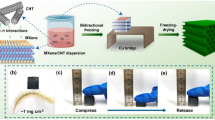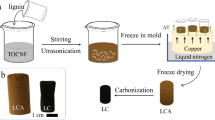Abstract
V2O5 nanobelt-carbonized bacterial cellulose (V2O5-CBC) nanocomposite was synthesized via a hydrothermal process in a single step. The prepared samples were characterized by XRD, SEM, and TEM. The results show that the CBC uniform covered on the surface of the V2O5 nanobelts. The specific capacitance of V2O5-CBC nanocomposite was investigated using cyclic voltammetry (CV) and galvanostatic charge-discharge (GCD). The results indicated that this material exhibited the capacitance of 281 F g−1 at 0.25 A g−1 and 268 F g−1 at 5 mV s−1. Moreover, the capacity can retain 87 % even after 2000 cycles.









Similar content being viewed by others
References
Yang J, Lan TB, Liu JD, Song YF, Wei MD (2013) Supercapacitor electrode of hollow spherical V2O5 with a high pseudocapacitance in aqueous solution. Electrochim Acta 105:489–495
Reddy RN, Reddy RG (2003) Sol–gel MnO2 as an electrode material for electrochemical capacitors. J Power Sources 124:330–337
Li ML, Sun GY, Yin PP, Ruan CP, Ai KL (2013) Controlling the formation of rodlike V2O5 nanocrystals on reduced graphene oxide for high-performance supercapacitors. ACS Appl Mater Interfaces 5:11462–11470
Bonso JS, Rahy A, Perera SD, Nour N, Seitz O, Chabal YJ, et al. (2012) Exfoliated graphite nanoplatelets–V2O5 nanotube composite electrodes for supercapacitors. J Power Sources 203:227–232
Lin ZY, Yan XB, Lang JW, Wang RT, Kong LB (2015) Adjusting electrode initial potential to obtain high-performance asymmetric supercapacitor based on porous vanadium pentoxide nanotubes and activated carbon nanorods. J Power Sources 279:358–364
Kudo T, Ikeda Y, Watanabe T, Hibino M, Miyayama M, Abe H, Kajita K (2002) Amorphous V2O5/carbon composites as electrochemical supercapacitor electrodes. Solid State Ionics 152-153:833–841
Wang NN, Zhang YF, Hu T, Zhao YF, Meng CG (2015) Facile hydrothermal synthesis of ultrahigh-aspect-ratio V2O5 nanowires for high-performance supercapacitors. Curr Appl Phys 15:493–498
Conway BE (1999) Electrochemical Supercapacitors. Kluwer Academic, Ottawa
Beguin F, Frackowiak E (2013) Supercapacitors materials, systems, and applications. Wiley-VCH, Weinheim
Perera SD, Patel B, Nijem N, Roodenko K, Seitz O, Ferraris JP, et al. (2011) Vanadium oxide nanowire-carbon nanotube binder-free flexible electrodes for supercapacitors. Adv Energy Mater 1:936–945
Kim HS, Popov BN (2002) Charaterization of hydrous ruthenium oxide/carbon nanocomposite supercapacitor prepared by a colloidal method. J Power Sources 104:52–61
Dong XC, Xu H, Wang XW, Huang YX, Chan-Park MB, Zhang H, Wang LH, Huang W, Chen P (2012) 3D graphene–cobalt oxide electrode for high-performance supercapacitor and enzymeless glucose detection. ACS Nano 6:3206–3213
Hou Y, Cheng YW, Hobson T, Liu J (2010) Design and synthesis of hierarchical MnO2 nanospheres/carbon nanotubes/conducting polymer ternary composite for high performance electro-chemical electrodes. Nano Lett 10:2727–2733
Wang YH, He P, Zhao XM, Lei W, Dong FQ (2013) Coal tar residues-based nanostructured activated carbon/Fe3O4 composite electrode materials for supercapacitors. J Solid State Electrochem 18:665–672
Ye GL, Gong YJ, Keyshar K, Husain EAM, Brunetto G, Yang SB, et al. (2015) 3D reduced graphene oxide coated V2O5 nanoribbon scaffolds for high-capacity supercapacitor electrodes. Part Part Syst Charact 32:817–821
Zhu JX, Cao LJ, Wu YS, Gong YJ, Liu Z, Hoster HE, et al. (2013) Building 3D structures of vanadium pentoxide nanosheets and application as electrodes in supercapacitors. Nano Lett 13:5408–5413
Wang Y, Takahashi K, Shang HM, Cao GZ (2005) Synthesis and electrochemical properties of vanadium pentoxide nanotube arrays. J Phys Chem B 109:3085–3088
Lee M, Balasingam SK, Jeong HY, Hong WG, Lee HBR, Kim BH, et al. (2015) One-step hydrothermal synthesis of graphene decorated V2O5 nanobelts for enhanced electrochemical energy storage. Sci Rep 5:8151–8158
Singh A, Chandra A (2015) Significant performance enhancement in asymmetric supercapacitors based on metal oxides, carnon nanotubes and neutral aqueous electrolyte. Sci Rep 5:15551–15562
Chen LF, Huang ZH, Liang HW, Guan QF, Yu SH (2013) Bacterial-cellulose-derived carbon nanofiber@MnO2 and nitrogen-doped carbon nanofiber electrode materials:an asymmetric supercapacitor with high energy and power density. Adv Mater 25:4746–4752
Wen LX, Ma YJ, Dai B, Zhou Y, Liu JS, Pei CH (2013) Preparation and dielectric properties of SiC nanowires self-sacrificially templated by carbonated bacterial cellulose. Mater Res Bull 48:687–690
Wang B, Li XL, Luo B, Yang JX, Wang XJ, Song Q, et al. (2013) Pyrolyzed bacterial cellulose:a versatile support for lithium ion battery anode materials. Small 9:2399–2404
Saravanakumar B, Purushothaman KK, Muralidharan G (2012) Interconnected V2O5 nanoporous network for high-performance supercapacitors. ACS Appl Mater Interfaces 4:4484–4490
Lee KY, Qian H, Tay FH, Blaker JJ, Kazarian SG, Bismarck A (2012) Bacterial cellulose as source for activated nanosized carbon for electric double layer capacitors. J Mater Sci 48:367–376
Chen LF, Huang ZH, Liang HW, Gao HL, Yu SH (2014) Three-dimensional heteroatom-doped carbon nanofiber networks derived from bacterial cellulose for supercapacitors. Adv Funct Mater 24:5104–5111
Reddy RN, Reddy RG (2006) Porous structured vanadium oxide electrode material for electrochemical capacitors. J Power Sources 156:700–704
Liu YY, Clark M, Zhang QF, Yu DM, Liu D, Liu J, et al. (2011) V2O5 nano-electrodes with high power and energy densities for thin film Li-ion batteries. Adv Energy Mater 1:194–202
Butler A, Clague MJ, Meister GE (1994) Vanadium peroxide complexes. Chem Rev 94:625–638
Alonso B, Livage J (1999) Synthesis of vanadium oxide gels from peroxovanadic acid solutions: a 51V NMR study. J Solid State Chem 148:16–19
Wang ZP, Ma YJ, He HL, Pei CH, He P (2015) A novel reusable nanocomposite: FeOOH/CBC and its adsorptive property for methyl orange. Appl Surf Sci 332:456–462
Fontenot CJ, Wiench JW, Pruski M, Schrader GL (2001) Vanadia gel synthesis via peroxovanadate precursors. 2. Characterization of the gels. J Phys Chem B 105:10496–10504
Acknowledgments
We are grateful to the Open Project of State Key Laboratory Cultivation Base for Nonmetal Composites and Functional Materials (No. 11ZXFX26). We are also grateful to the apparatus support of the Analytical and Testing Center of the Southwest University of Science and Technology.
Author information
Authors and Affiliations
Corresponding author
Rights and permissions
About this article
Cite this article
Mei, J., Ma, Y. & Pei, C. V2O5 nanobelt-carbonized bacterial cellulose composite with enhanced electrochemical performance for aqueous supercapacitors. J Solid State Electrochem 21, 573–580 (2017). https://doi.org/10.1007/s10008-016-3392-3
Received:
Revised:
Accepted:
Published:
Issue Date:
DOI: https://doi.org/10.1007/s10008-016-3392-3




